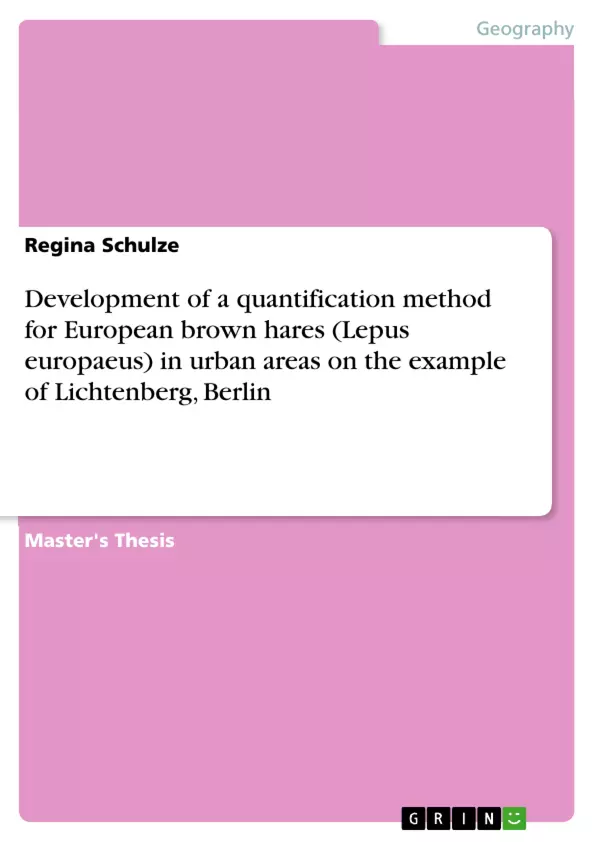The stock of the European brown hare (Lepus europaeus PALLAS, 1778) is declining since decades, in Germany as well as in other European countries.At the same time,the occurrence of European brown hares is a new phenomenon in urban areas. Hence,Lichtenberg, a city district of Berlin, the capital of Germany, even assumed a special responsibility for its new inhabitants.
Whereas a method for the quantification of this common game species in agricultural areas already exists, a new quantification method for city habitats is required in order to overcome several limitations.
The aim of this master thesis is to deliver a suitable quantification method for Lepus europaeus, which can be applied by nature conservation authorities in future.
By means of a strong LED torchlight and a bike, 153.74 ha of green area, which is usually scattered between residential buildings, were investigated in the style of the previous “spotlight taxation”. These investigated areas belong to five different tracks. Each track
was investigated three times in the late evening hours in the spring period from 8th of March until the 25th of April 2011. Within this time 37 sightings of hares have been made. Summing up the five maximum values from each of the 3 countings, one could assume that at least 17 hares live within the illuminated area. Considering the territorial behaviour, even a minimum number of 19 hares is probable. If additionally only suitable tracks are taken into account, a density of 16.98 hares/100 ha can be calculated ‒ a
surprisingly high value compared to the results of spotlight counting in surrounding federal states, where the agricultural landscape, and therefore the natural habitat of Lepus europaeus, is more prevalent. However, a direct comparison to the hare densities in
the open landscape, which are obtained by means of different methods is incorrect. Nevertheless, if the proposed aspects for a future implementation will be taken into consideration in the long run, it is a realisable method for the quantification of urban hare populations. Moreover, the interested public can participate on this scientific approach as well. Then, cost reduction and the rising awareness for wild animals in the public are positive side-effects.
Inhaltsverzeichnis (Table of Contents)
Zielsetzung und Themenschwerpunkte (Objectives and Key Themes)
The text aims to develop a quantification method for assessing the presence of European brown hares (Lepus europaeus) in urban areas.
- Quantification method for European brown hares in urban areas
- Analysis of hare tracks, illumination plots, and positions
- Use of digital orthophotos and geographic information systems (GIS)
- Assessment of hare populations in the Lichtenberg district of Berlin
- Comparison of counting results across different time periods
Zusammenfassung der Kapitel (Chapter Summaries)
The preview does not include summaries of the conclusion, final chapter, or any sections containing major revelations or spoilers.
Schlüsselwörter (Keywords)
The key terms and focus topics of this work include European brown hares, quantification methods, urban areas, geographic information systems (GIS), track analysis, illumination plots, Lichtenberg district, Berlin, and hare population assessment.
- Quote paper
- Regina Schulze (Author), 2011, Development of a quantification method for European brown hares (Lepus europaeus) in urban areas on the example of Lichtenberg, Berlin, Munich, GRIN Verlag, https://www.hausarbeiten.de/document/196315


